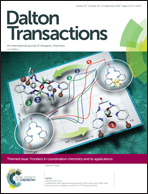Tuning the spin crossover behavior of the polyanion [(H2O)6Fe3(μ-L)6]6–: the case of the cesium salt†‡
Abstract
The magnetic behavior of the polyanion [Fe3(μ-L)6(H2O)6]6– (L2– = (1,2,4-triazol-4-yl)ethanedisulfonate) as the corresponding dimethylammonium salt shows memory effect above room temperature, with a dynamic thermal hysteresis cycle over 90 K and temperature-induced excited spin state trapping (TIESST) phenomena at the highest temperatures reported. Taking advantage of the polyanionic nature of this trimetallic complex, we were able to substitute the dimethylammonium cations by the monovalent heavy alkali metal cesium. This methathesis yielded the salt Cs6[Fe3(μ-L)6(H2O)6], with different molecular packing that increases the number and strength of cation–anion interactions, including a more robust H-bonded network. In this phase, the spin transition still occurs above room temperature, but it is more abrupt and narrow (≈50 K wide hysteresis). Despite these differences, TIESST is observed with almost identical characteristic temperature (TTIESST = 240 K) than in the parent compound, which is an additional experimental evidence supporting the molecular origin of the TIESST behavior in these materials.
![Graphical abstract: Tuning the spin crossover behavior of the polyanion [(H2O)6Fe3(μ-L)6]6–: the case of the cesium salt](/en/Image/Get?imageInfo.ImageType=GA&imageInfo.ImageIdentifier.ManuscriptID=C8DT01339J&imageInfo.ImageIdentifier.Year=2018)
- This article is part of the themed collection: Frontiers in coordination chemistry and its applications


 Please wait while we load your content...
Please wait while we load your content...